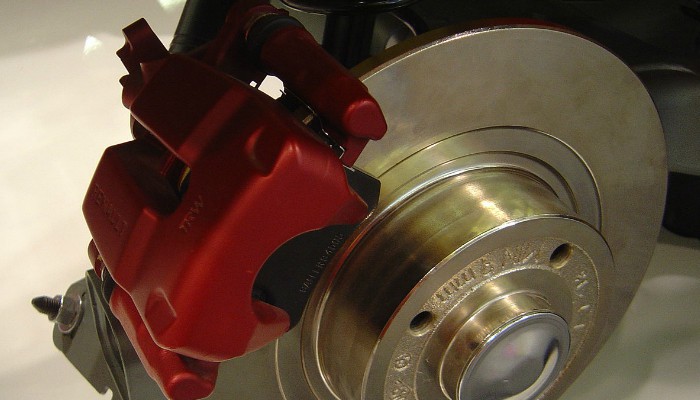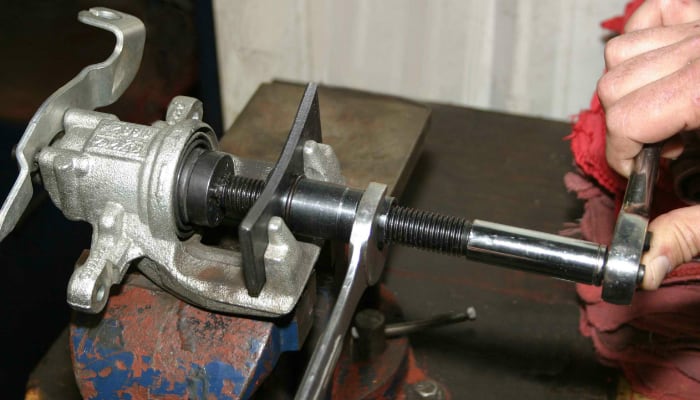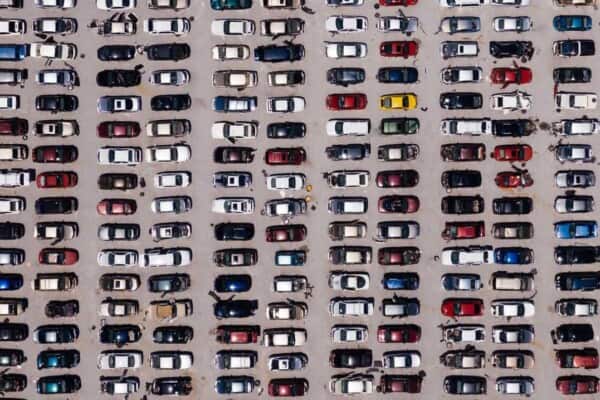Without brake calipers, the braking system of a car will collapse. That’s how vital brake calipers are. These vehicle components join the brake pads together so both will make contact with the brake rotor’s surface to slow down the car or stop it completely. Let’s learn more about brake calipers!
The Brake System
To fully understand the importance of brake calipers, we must be familiar with relevant technical terms and other components comprising a car’s braking system.
Disc Brakes
The majority of cars nowadays contain disc brakes but only in the front wheels usually. Although, some vehicles also have disc brakes at the back. In this brake system, the wheels connect to rotors or discs composed of metal. Meanwhile, the brake caliper looks like a clamp above the rotor.

Brake Pads
Looking at a caliper, two plates made of metal connected to a specific material which initiates friction. The right term for these metal plates is brake pads. There are two types of brake pads: outboard and inboard. Obviously, outboard brake pads are located outside the rotors. They are facing the curb. Inboard brake pads are inside the rotors, facing the car.

Once the brake pedal is compressed, the master cylinder’s fluid makes hydraulic pressure in the caliper’s pistons. This part of the process forces the brake pads to make contact with the rotor. The friction material of the pads is so strong that it can really affect the rotor’s movement. Since the rotor is connected to the wheel, its dynamic is followed by the latter all the time. For a functioning car, it is impossible for the rotor and the wheel to not work simultaneously.
Drum Brakes
This type of brake system is only found in old vehicle models. It contains a rotating drum with brake shoes inside. These two components in the drum brake system create friction to slow the wheels. Their friction gathers gases and heat into the drum, resulting in brake fade or loss of power for braking the car. That’s why drum brakes are not used in new cars.

The disc brake is more reliable than the drum system because its brake pads are not contained inside a metal interior. Brake pads need to be ventilated to avoid fast accumulation of heat. Drum brakes can still be used nowadays as long as they are located in the rear. Rear wheels do not need too much braking power.
Types of Brake Calipers
Brake calipers have two major types: floating and fixed. Floating can also be called sliding calipers. Check out the similarities and differences of floating and fixed brake calipers:
Floating Brake Calipers
The movement of floating brake calipers is in-and-out motion. This type of brake calipers only has a maximum of two pistons on the rotor’s inner side. The piston compresses the whole caliper after you step on the brake pedal, resulting in friction on each side of the rotor thanks to the brake pads.
Fixed Brake Calipers
Floating brake caliper is the total opposite of fixed. While floating calipers follow a certain motion, fixed ones do not move at all. Fixed calipers also have their pistons on both the inner and outer sides of the rotor. The downside for this type of brake caliper is the cost of pistons. Some fixed calipers contain more than two pistons on both sides. A rotor can actually have a dozen pistons surrounding it, only if the car owner can handle expenses.
Brake Calipers vs. Vehicle Size
Clamping force is the basis of how powerful a brake caliper is in stopping a vehicle. It specifically refers to the force being applied on a rotor’s surface. A strong clamping force can only be possible if the friction material of the brake pad is effective and wide. Also, the quantity of pistons can affect the force.
Trucks and SUVs are definitely larger than standard cars. They have heavier accessories and bigger tires. They can carry more passengers and load, resulting in a heavier overall weight. Thankfully, truck brake calipers are available in the market right now. Their surface area is two times more than standard floating calipers.
There are more differences when trucks and cars are compared, so check out the pros and cons for each vehicle.
Symptoms of Damaged Brake Calipers
Watch out for these symptoms to solve the issue immediately before it gets worse:
Abnormal Vehicle Movement
Cars with damaged brake calipers cannot move in a straight line sometimes. When one wheel is slower than the other because of brake drag, the vehicle tends to move side to side on the road. Vibrations can also happen when you step on the brake, but there are more factors regarding that scenario.
Strange Noises
The sounds will actually come from the wheels while the driver is stepping on the brake. High-pitched sounds and thuds can represent damaged brake calipers. One caliper might be loose or stuck.
To prove that sounds can signify car problems, find out why a steering wheel clicks while turning. A vehicle can also squeal while turning, so check out the reasons behind it.
Leaks
Brake fluid is sealed inside a rubber boot. Brake calipers really need to use it in order to operate properly. However, their seal or protection can still wear out due to heat from braking. A damaged seal or boot can definitely trigger leaks.
Maintenance
When it comes to brake caliper maintenance, a couple of ideas comes to mind. Check these out:
Brake Caliper Tool
Brake pads are the most fragile components of calipers. After all, they are the ones doing the dirty work. As expected, they eventually wear out after making harsh contact with a moving rotor many times. Worn-out brake pads are way thinner than their original look.

Damaged brake pads just need to be replaced, that’s all. The challenge is to remove the piston from the caliper before replacing the pads. What you should do is to push back the piston into the brake caliper by using the right tool. A piston is designed like a screw, so you cannot just remove it by hand. Some people may resort to pliers, but these tools are not recommended since they can hurt your hands or damage both the caliper and the piston.
One end of the brake caliper tool is placed above the piston while the other contains the handle for rotation. As you rotate the tool, the piston returns to the caliper.
Service
The pins of floating brake calipers need professional attention when they start to stick. Rust and dirt are two common reasons why floating calipers encounter mechanical issues. The results? The caliper cannot separate the brake pad away from the rotor, creating more friction than necessary. In addition, the rotor will suffer from extreme heat.
Summary
The brake system is composed of several parts, but the brake calipers stand out because their main function is too crucial. Without them, brake pads cannot stop the rotor from moving whenever necessary. Never forget to include the brake calipers in your regular maintenance check.
On the other hand, you might want to check out our take on AC Compressor and know how it works.











